Snake eels - Ophichthidae
SNAKE EELS - OPHICHTHIDAE
Snake eels are rarely seen by underwater tourists, because most of the time it’s only the head that sticks out of the sand, mud or coral rubble. As muck diving became popular, more and more species of snake eel have been discovered. Only a few of the species leave their hiding place during the night to hunt on small fish. It takes them only a few seconds to dig themselves into the substrate. Some species dig a hole with their bony tail while others dig with their head. They are able to swim backwards and forwards. Because of the shape and movements, many people confuse them with sea snakes. Length: 80 cm.Distribution: Thailand to the marshall Is, French Polynesia, S- Japan and Australia.Brown to yellow colour with some small black spots, white encircling bar behind the head. Pale area between the nostrils and the eyes. Solitary, during daytime only the head sticks out of the sand.Coastal areas, down to -10 m. Length: 75 cm.Distribution: from E- Africa to S- Japan, Indonesia and Society Is. in Fr. Polynesia.Greyish body with dark brown encircling bars, large white-greyish saddle in the neck. The head and nostrils have dark-edged bronze spots, gold to bronze coloured eye. Lives solitary, buried in sand with the head exposed. Comes out at night. Prefers coastal sand slopes, from -5 to -20 m. Length: 90 cm.Distribution: Red Sea, S- Africa to SW- Japan, French Polynesia and Australia. White-grey-ish with dark brown bars, overhanging snout. Small pectoral fins.Lives solitary on shallow sand flats of lagoons and seaward reefs, from -1 to -30 m. Mostly confused with the sea snake Laticauda colubrina. Digs into sand and holes to look for prey. Length: 100 cm.Distribution: throughout the whole Indo- Pacific.It ambushes itself in sand and waites for prey. It looks if the eyes have a glass cover for protection against the sand. Red-orange to cream colour.Lives in sandy bottoms from intertidal waters to -12 m. Feeds on small fish. Length: 120 cm.Distribution: from E- Africa to SW- Japan, French Polynesia and Northern Australia.From bright white to a more creamy colour with small darker spots.Eyes are set forward, close to the mouth. Lives solitary, buried in sand down to the eyes. Mostly only seen swimming during night time. On sand patches of lagoons and seaward reefs, from -50 cm. to -15 m. Length: 125 cm.Distribution: From the Red Sea to S- Japan, Indonesia and Papua New Guinea.Brown body with irregular lighter patches, small black spots on the head and numerous fine teeth. Lives solitary, buried in sand with head exposed to ambush prey. In sandy areas of coastal waters, down to -10 m. Length: 125 cm.Distribution: from the Red Sea to S- Japan, Indonesia and Papua New Guinea.Brown body with irregular lighter patches, small black spots on the head and numerous fine teeth.Lives solitary, buried in sand with head exposed to ambush prey.In sandy areas of coastal waters, down to -10 m. Length: 40 cm.Distribution: from E- Africa to the Marshal Is. and Great Barrier Reef.White body with numerous rusty brown spots which sometimes form patches.Pointy (shark looking) snout, no pectoral fins. Lives solitary and mostly buried into sand with the head sticking out.Mostly found in large sandy areas of seaward slopes, from -2 to -25 m.

Snake eels info

Brachysomophis cirrocheilos - Stargazer snake eel

Brachysomophis crocodilinus - Crococodile snake eel

Brachysomophis henshawi - Reptilian snake eel

Apterichtus klazingai - Sharpsnout snake eel

Callechelys marmorata - Marbled snake eel

Ophichthus melanochir - Black finned snake eel

Ophichthus bonaparti - Napoleon snake eel

Ophichthus polyopthalmus - Many-eyed snake eel

Leiuranus semicinctus - Saddled snake eel

Myrichthys colubrinos - Banded snake eel

Myrichthys maculosus - Spotted snake eel

Muraenichthys sp - Worm-eel

Conger cinereus - longfin conger eel

Ophichtus cephaloza - Dark-shouldered conger eel

Ariosoma anagoides - Bigeye conger


